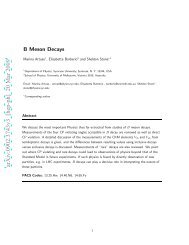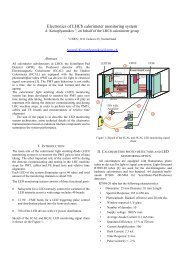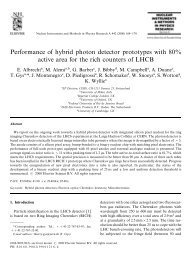PI/LHCb presentation - LHCb - Cern
PI/LHCb presentation - LHCb - Cern
PI/LHCb presentation - LHCb - Cern
You also want an ePaper? Increase the reach of your titles
YUMPU automatically turns print PDFs into web optimized ePapers that Google loves.
High Luminosity Running<br />
- extreme case: observed up to 2.3 pile-up (ν =1.9) in recorded events at beginning of fill,<br />
<strong>LHCb</strong> designed to run at ν = 0.7 (@ 14 TeV)<br />
take the opportunity of low bunch rate, to gain luminosity – try it now or never<br />
- very high occupancy,<br />
e.g. Outer Tracker occupancy goes up to 20%<br />
larger event size (85kB, before 35kB)<br />
- significantly slower for HLT & offline<br />
processing and stripping<br />
- ghost/fakes rates,<br />
efficiency needs to be studied<br />
(initial MC studies indicated decent behaviour)<br />
track multiplicity<br />
Stephanie Hansmann-Menzemer 102 nd LHCC Meeting, 07.07.2010 8<br />
CPU time/event in tracking (wo fitting)<br />
exponential increase<br />
- optimal compromise between quantity and quality of physics data need<br />
to be found taking short and longterm physics goals into account.<br />
- We have the flexibility to choose our working point!<br />
- several potential options (if needed):<br />
- cut on track multiplicity early at HLT 1 and/or tighter (nominal) cut at L0<br />
- need more testing/commissioning: beam offset in vertical plane/bunches of lower intensity<br />
- longer term solution: larger β* for <strong>LHCb</strong>













